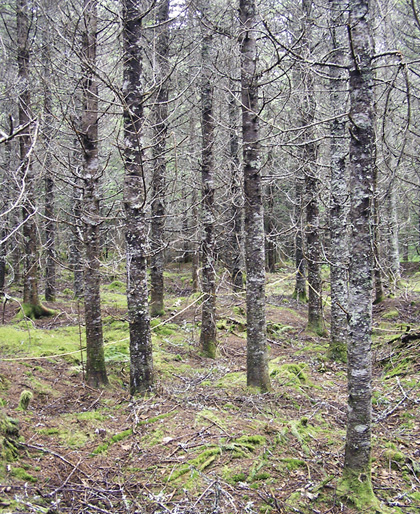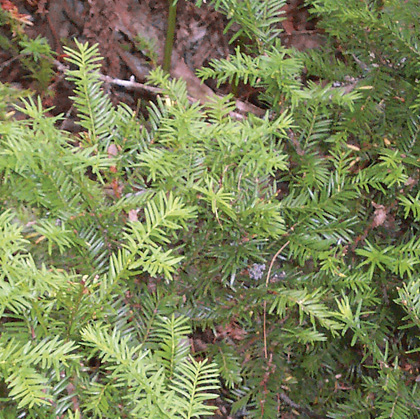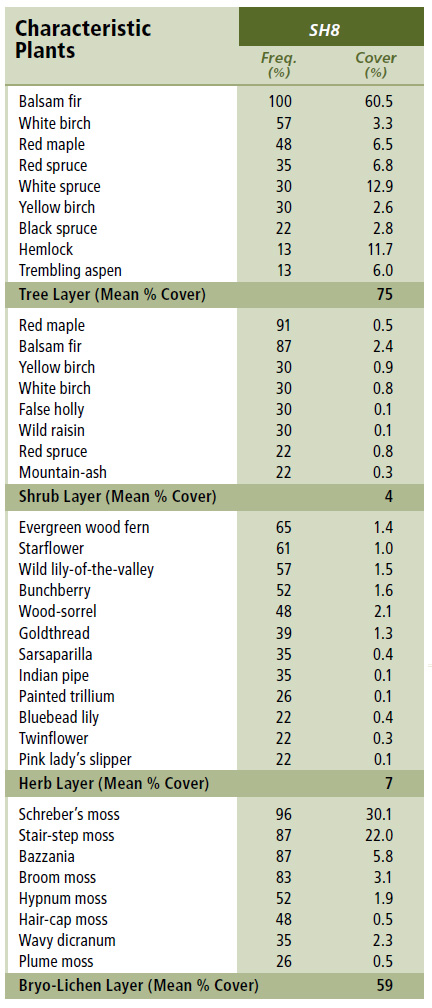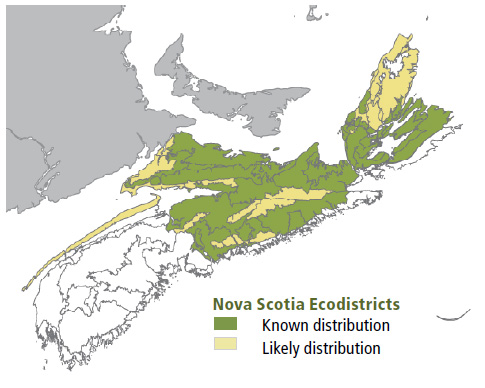
Forest Vegetation types - SH8
SH8 — Balsam fir / Wood fern / Schreber's moss
Picea glauca – Picea rubens / Vaccinium spp. / Pleurozium schreberi
 |
MacInnis Lake, Cape Breton County |
Concept:This early to mid-successional Vegetation Type (VT) has abundant balsam fir with minor amounts of other softwood and hardwood species. Due to the short-lived nature of balsam fir, this VT is often associated with significant coarse wood debris (CWD) and/or snags, as well as extensive balsam fir regeneration. Balsam fir / Wood fern / Schreber's moss usually follows stand-replacing disturbance events such as insect infestation, windthrow or harvesting.
Vegetation: Balsam fir is the dominant overstory tree, with varying amounts of red maple, red spruce, white spruce, black spruce, white birch and yellow birch (although not usually all found in one stand). Balsam fir regeneration can be extensive, with red maple usually present in lesser amounts. Other shrubs include false holly, wild raisin and mountain-ash. Typical herb species include evergreen wood fern, starflower, wild lily-of-the-valley, bunchberry, goldthread and wood sorrel. The often extensive bryophyte layer is made up of Schreber's moss, stair-step moss, wavy dicranum, broom moss, hypnum moss and bazzania.
Environmental Setting: SH8 is mainly associated with fresh to moist, nutrient poor to medium soils of glacial origin. These soils are generally medium to coarse textured and often stony. This VT is found throughout mainland Nova Scotia and on the Cape Breton lowlands. SH8 is common and abundant across lower elevations of the other Maritime provinces.
Successional Dynamics: SH8 is a predominantly even-aged, mid-successional VT dominated by balsam fir. This VT usually follows stand-replacing disturbances from insect infestation, windthrow or harvesting. On the Cape Breton lowlands SH8 will perpetuate from advanced regeneration as the overstory deteriorates. Spruce budworm epidemics can also cause a shift to an earlier successional stage dominated by white birch, red maple and aspen (e.g. IH4 and IH6). On mainland Nova Scotia, SH8 may succeed to SH5 (Red spruce – Balsam fir / Schreber's moss) or SH6 (Red spruce – Balsam fir / Stair-step moss – Sphagnum).
Ecological Features: This closed canopy forest occurs primarily on mainland Nova Scotia, where it typically forms matrix and large-patch ecosystems. Balsam fir acts as a nurse species, promoting red spruce and hemlock regeneration. The short life-span of balsam fir contributes substantial coarse woody material to the ecosystem, often in pulses following insect outbreaks, disease or wind storms. Balsam fir is very shade-tolerant in the understory and can sustain a significant presence throughout successional development. Mature forests may provide habitat for numerous mammals (including flying squirrels, moose, deer), numerous bird species, and lichens (including abundant old man's beard, an important food and nest material). No plant or lichen species of conservation concern were found in available plot data.
 |
| Ground hemlock (Yew) |
Distinguishing Features: This softwood forest primarily of balsam fir usually follows a stand-level disturbance such as harvesting. This unit is not associated with coastal areas or the Cape Breton highland plateau.
| Slope Position: | Upper4 Level2 Lower2 Middle1 Crest1 |
Surface Stoniness: |
(Non - Slightly)6 (Moderately)3 (Very - Excessively)1 |
Bedrock Outcrop: |
(Non-rocky)9 (Slightly - Moderately)1 |
Elevation Range: |
23 - 226m |
Slope Gradient: |
Gentle4 Level2 Moderate2 Other1 nd1 |
Aspect: |
North1 East2 South1 West2 None4 |
Exposure: |
Moderate5 Mod. exposed3 Other2 |
Microtopography: |
Slightly5 Moderately3 Strongly1 Other1 |
Drainage: |
Well4 Moderately well3 Imperfect2 Other1 |
Soil Type: |
ST25 ST32 ST2-L1 ST3-L1 ST61 |
Parent Material: |
Glacial till7 Glaciofluvial2 Till/Bedrock1 |
Rooting Depth (cm): |
(<30)2 (30-45)4 (>45)3 nd1 |
Duff Thickness (cm): |
(0-5)2 (6-10)5 (11-20)2 nd1 |

